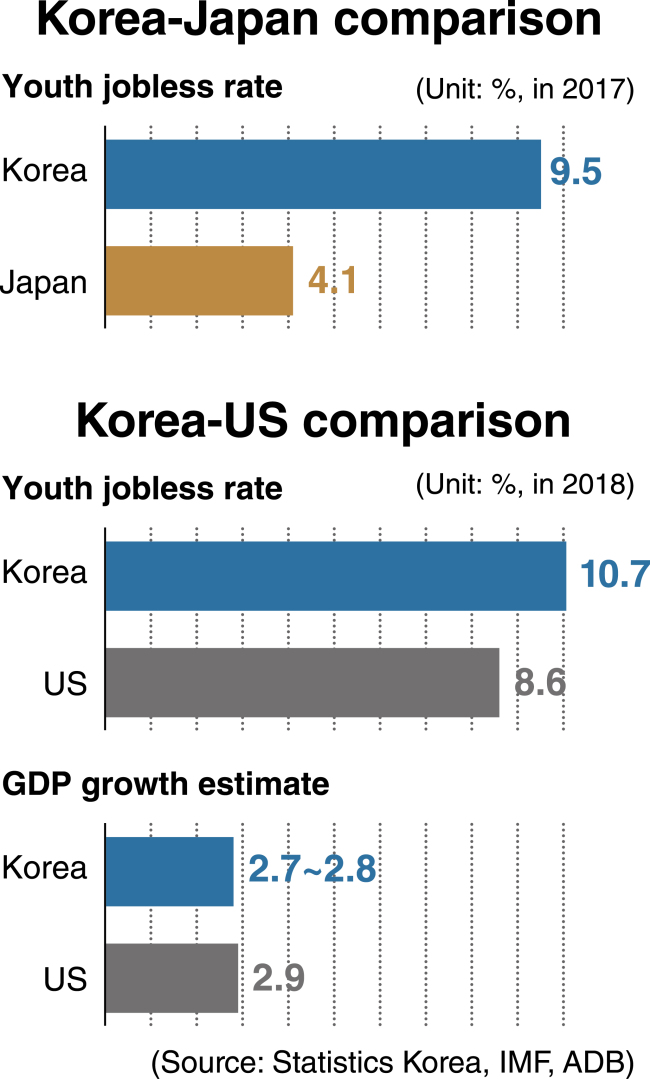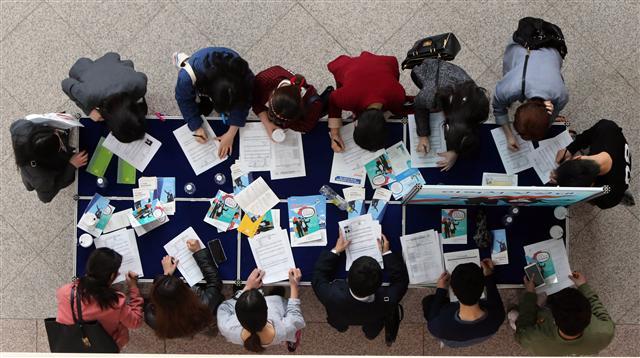SEJONG -- Global research organizations have revised their growth outlook for the South Korean economy, predicting its GDP growth in 2018 and 2019 would stay under 3 percent.
The International Monetary Fund forecasted the Korean economy would expand only 2.8 percent this year and 2.6 percent next year. The Asian Development Bank’s prediction was 2.7 percent and 2.6 percent, respectively, which is 0.2 percentage point lower for both years compared to its earlier estimates.
The forecasts contrast to the Moon Jae-in administration’s policy direction of “income-led” growth, triggering concerns that Korea’s GDP growth may fall behind that of the world’s largest economy, the US.
The IMF has predicted that the US economy would expand 2.9 percent on-year in 2018, which exceeds its growth projection of 2.8 percent for the world’s 12th-largest economy, South Korea.
Furthermore, macro-economy experts have raised the possibility that Korea may surpass the US in unemployment rate in the coming months. As of the third quarter of 2018, Korea saw its jobless rate reach 3.8 percent, close to the 3.9 percent recorded in the US.
 |
(Korea Herald) |
In the third quarter of 2011, Korea and the US recorded unemployment rates of 3.2 percent and 9 percent respectively.
The gap in the unemployment rates of the two countries has narrowed in the past few years, reaching a mere 1 percentage point in the first quarter of 2017, with Korea’s rate at 3.6 percent and the US’ at 4.6 percent.
For the first eight months of this year, Korea saw the number of unemployed come to 1.129 million per month on average, up 45,000 from the same period in 2017. The 2018 figure is the highest since the nation began to record related data in 1999.
In addition, Korea’s jobless rates among youths between 15 and 24 years old and seniors between 55 and 64 years old have already surpassed that of the US.
As of July 2018, Korea recorded a youth jobless rate of 10.7 percent, higher by 2.1 percentage points than the rate of 8.6 percent among young US citizens.
As for seniors, the rates in Korea and the US marked 2.9 percent and 2.7 percent, respectively, as of the second quarter of this year. This is the first time in 17 years that Korea’s senior jobless rate has exceeded the US’ since the first quarter of 2001.
In addition, Korea stands in contrast to the Organization for Economic Development and Cooperation in recent years. The 35-member-state OECD saw an unemployment rate of 6 percent in the first quarter of 2017, which dropped to 5.3 percent in the second quarter of 2018, in contrast to the trend in Korea.
 |
College graduates gather at a job fair in Daejeon. (Yonhap) |
Konkuk University professor Oh Jung-keun said, “Youth unemployment, which stands at about 10 percent, is estimated to be far more serious when the real sentiment is reflected.”
A report from the Hyundai Research Institute said that the sentiment-reflected jobless rate among young citizens hovered at 32 percent, suggesting that it is difficult to classify involuntary irregular workers as employed.
“The administration has only accelerated in raising the statutory minimum wage,” said Dankook University professor Kim Tae-gi. He also pointed out that the government has neglected easing regulations and expanding the flexibility of the labor market.
Experts have continued to urge the government to eliminate regulatory hurdles for service sectors, such as finance, logistics and tourism, to create more jobs.
A former civil servant, who had worked for Government Sejong Complex, raised a need to study the case of Japan. He cited that Japan had lowered the unemployment rate among those between 25 and 29 years old to 4.1 percent last year, which is quite low compared with 9.5 percent for the same age group in Korea.
“Japan, which suffered economic difficulties in the 1990s, has been active in providing youths with a variety of job-training and employment information under consistent support from its past and current administrations,” he said.
By Kim Yon-se (
kys@heraldcorp.com)









